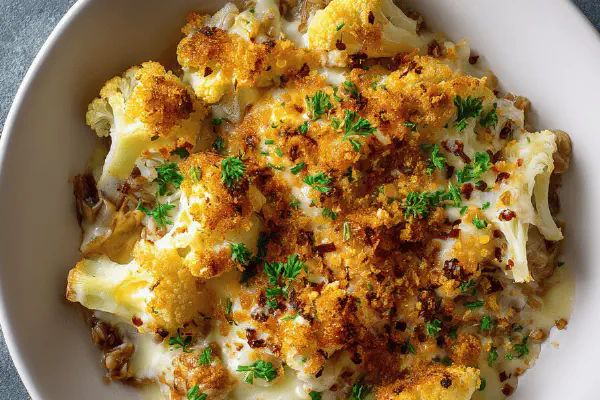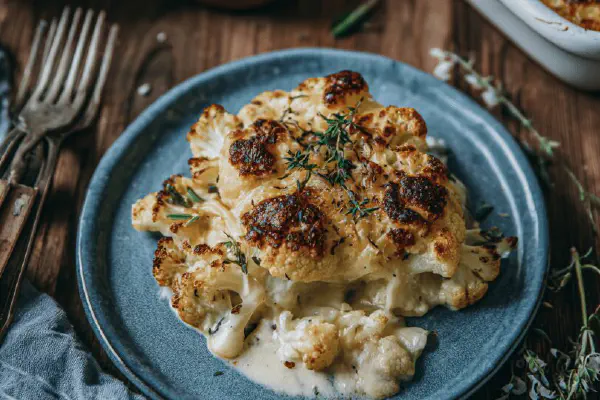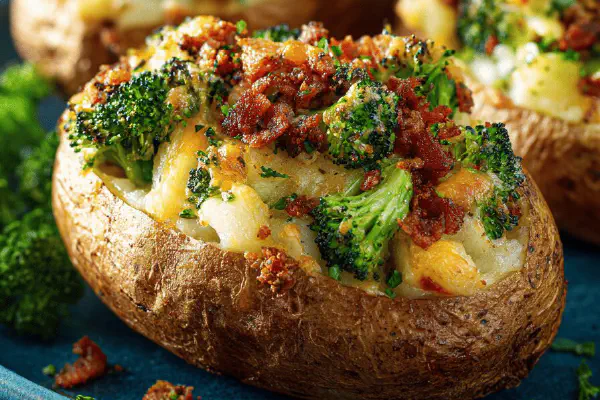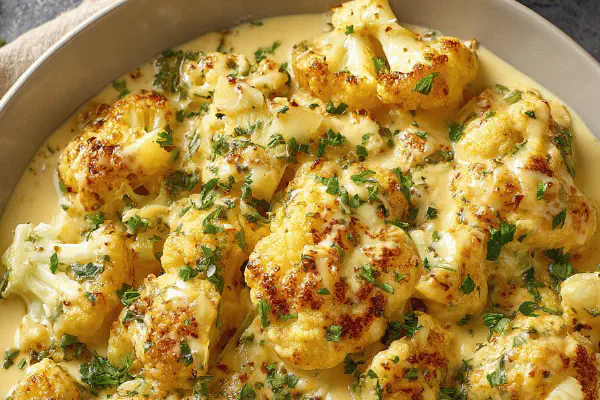Cauliflower Spelt Gratin

By Emma
Certified Culinary Professional
Ingredients
Spelt
- 2 shallots, finely chopped
- 3 cloves garlic, minced
- 45 ml (3 tbsp) olive oil or clarified butter
- 180 g (3/4 cup) pearled spelt grains
- 125 ml (1/2 cup) dry white wine
- 700 ml (3 cups) vegetable stock or chicken stock
- 1 sprig fresh oregano
Gratin
- 1 medium cauliflower, cut into florets
- 55 g (1/4 cup) unsalted butter
- 40 g (1/4 cup) unbleached all-purpose flour
- 700 ml (3 cups) whole milk
- 45 g (1/2 cup) freshly grated Parmesan cheese
- 1 ml (1/4 tsp) smoked paprika
- 1 ml (1/4 tsp) cayenne pepper
- 30 ml (2 tbsp) panko breadcrumbs
- 100 g (1 cup) grated Gruyère or other firm cheese
- 1 tsp preserved lemon zest (optional)
About the ingredients
Method
Spelt
- 1. Heat a large, ovenproof skillet over medium-high. Sizzle shallots and garlic in oil until translucent for about 3 minutes. Toss in pearled spelt, stir vigorously 90 seconds to toast lightly; get that nutty smell. Season with salt and pepper.
- 2. Pour in white wine. Let it bubble down nearly dry, watch closely; don’t burn. Add stock and fresh oregano sprig. Bring to a low boil. Cover and drop heat to medium-low. Cook covered for around 18 minutes. Check now and then; absorbency varies. Spelt should be tender with a slight chewiness.
- 3. Remove from heat, discard oregano, adjust seasoning. Set aside. Keep warm but not dry.
Gratin
- 4. Meanwhile, preheat oven to 205 °C (400 °F). Rack in center position.
- 5. Blanch cauliflower florets in salted boiling water 4-6 minutes. Feel with a fork; should pierce with slight resistance. Drain thoroughly; moisture fights your crust.
- 6. In saucepan over medium heat, melt butter completely. Whisk in flour. Stir constantly 1-2 minutes to cook off raw taste; flour paste will bubble slightly. Gradually whisk in milk. Increase heat to bring mixture to gentle boil while whisking steadily. The sauce thickens and coats the spoon; take it off just before it gets too thick—keep stirring to avoid lumps.
- 7. Off heat, whisk in Parmesan, smoked paprika, cayenne, plus a pinch of salt. Stir in preserved lemon zest if using; it brightens the béchamel, balancing richness.
- 8. Toss cauliflower gently into the spelt pan. Pour béchamel over evenly.
- 9. Combine panko and remaining Parmesan in a small bowl for crunchy topping. Sprinkle panko cheese mix across the surface, then scatter grated Gruyère.
- 10. Cover pan loosely with foil or lid. Chill at this point if you want; when cold, increase baking time by 10 more minutes.
- 11. Bake uncovered for 15-20 minutes to golden top. Look for bubbling edges and a crust with color, deepening to amber.
- 12. Remove from oven. Let rest 10-15 minutes to finish setting and cool slightly. Texture firm enough to portion without falling apart but still melty inside.
- Serve alongside kale and celery Waldorf salad or a simple green for contrast.
Cooking tips
Chef's notes
- 💡 Start spelt with shallots and garlic sizzling — key step for nutty aroma; toast grains well but toss constantly or burns sneak in quick. Watch wine bubble down near dry before adding stock, that acidity cuts grain’s earthiness. Oregano sprig adds herbal lift—don’t leave in final dish or bitterness creeps.
- 💡 Blanch cauliflower until fork pokes with gentle resistance. Too soft equals mush, too firm stays raw after bake. Drain thoroughly—wet florets kill crust texture. The surface moisture hinders browning at oven stage; dry florets crisp up better under heat.
- 💡 Béchamel needs constant whisking over low heat. Raw flour taste when skipped messes whole sauce. Look for sauce thick enough to coat spoon but not gluey. Add smoked paprika and cayenne off heat—too early dulls their punch. Parmesan folds in last to keep sauce creamy, not grainy.
- 💡 For crunchy top, mix panko breadcrumbs with Parmesan; avoids soggy crust and adds contrast. Sprinkling grated Gruyère on top after panko lets cheese brown nicely. If chilling before bake, add 10 minutes extra baking to compensate for cold pan and sauce.
- 💡 Butter swap? Clarified butter preferred for browning without burning. Olive oil adds fruity notes but smoke point lower—watch heat carefully. Vegan switches work; try coconut oil for butter, cashew milk instead of cow milk but sauce thickening needs tweaks—extra flour or longer whisking.
Common questions
Can I use whole spelt instead of pearled?
Takes longer, tough outer husk sticks unless soaked well. Pearled skips soak, cooks evenly. Whole spelt best if pre-soaked several hours, else ends chewy or hard in baking. Adjust cooking liquids up slightly.
What to do if béchamel lumps form?
Happens if whisking stops or heat too high. Warm milk slowly, add gradually to flour paste while whisking vigorously. If lumps appear, strain sauce or blitz with immersion blender after cooling a bit. Small lumps usually OK if stirred well in final dish.
How to prevent crust from burning before inside cooks?
Cover loosely with foil to shield top while baking longer. Remove foil last 15-20 minutes to crisp. Panko topping helps shield direct heat but watch oven rack position — middle is best to avoid burning.
Storage and reheating tips?
Cool completely first, cover tightly or freeze in airtight container. Reheat under broiler or in oven to bring back crisp topping. Microwave softens crust, so better for quicker reheating but expect less crunch. Use leftovers within 3-4 days refrigerated.



